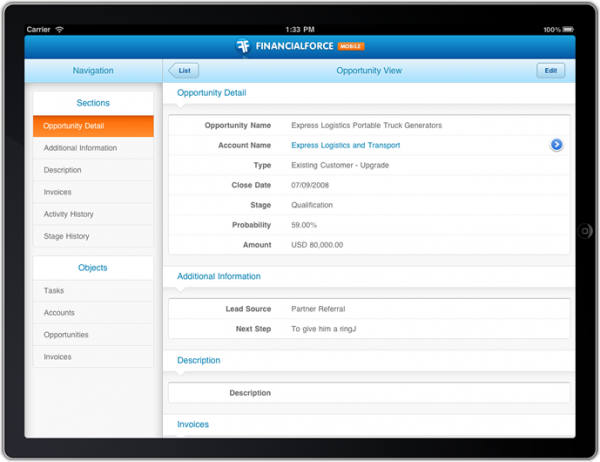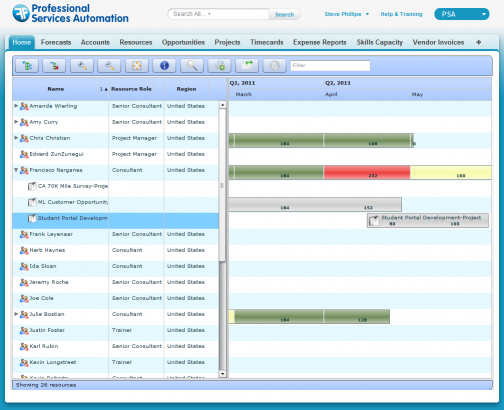Accounting
Professional Services Automation (PSA)
The Competitive Edge of Cloud Apps Built on Force.com
FinancialForce.com develops cloud-based apps to help run your business more smoothly in the areas of financial management and professional services automation. Built on salesforce.com’s Force platform, FinancialForce.com’s strength lies in building business logic around existing cloud technology. We sat down with President & CEO Jeremy Roche to talk about the benefits of Force.com, the importance of social, and succeeding in the increasingly complex world of cloud apps.

WEBSITE: www.financialforce.com
FOUNDED: 2009
LOCATION: San Francisco, CA
CUSTOMERS: ICEF, Pandora, Blue Shield of California, CyberSafe, Esker
Who is FinancialForce.com and what is your mission?
We set out to do for the back office what salesforce.com did for the front office. That’s the simplest way to describe it. You can think about it as building the next generation of cloud applications that are designed to take business transactions generated from companies selling things, and then turning them into the business process that goes beyond that to complete the entire cycle. So in the accounting space, we go from invoice to cash to general ledger. In the professional services space, we go from selling the work to doing the work to billing for the work to collecting on it, all the way to accounting.
What advantage do you have by building your products on the Force.com platform?
Salesforce provides more than just a hosting platform. What they actually provide is the toolkit that they use to build their own applications. So that means that our development team is focused on building business functions, not on the core plumbing, because salesforce.com does that for us.
A good example would be this: we don’t build a workflow engine or security model. We inherit those straight from salesforce. Another example is salesforce’s Chatter product, which makes our software social. We take those core building blocks, and then we wrap business logic and context around them. So if you look at how Chatter is built into our professional services application, you’ll see it in the project wall for instance, where consultants can collaborate with each other and with the customers.
Force.com gives us a lot of velocity in our development, and it also keeps us very focused on the business side of it. We don’t have to worry about scaling our data centers or disaster recovery, because that’s all handled for us by salesforce.
How was FinancialForce.com founded?
We were founded in September 2009 by a Dutch company called Unit4 and by salesforce. The product began its life within Unit4, and then salesforce and Unit4 together to create a new cloud company, which became FinancialForce.com.
What do you do to ensure you stand out from the industry noise?
We’re building modern versions of applications that have been around for many years, so there are lots of competitors. And a lot of the noise comes from everybody doing everything in the cloud these days.
The way we stand out is first and foremost by building on the Force.com platform, which gives us a unique edge. There are other people building on the platform, but we were very early and have built up a significant customer base. The next thing is our positioning. We focus on business processes and on the things that people with traditional applications don’t like, like how long it takes to deploy and the flexibility once you’ve deployed.
If you look at our customer base, you’ll see we take specialist services and we’re doing everything you would suspect in a traditional fulfillment-type business. But we also have customers in spaces like oil and gas, with specialized security and government departments. They don’t sell professional services, but they do have skills, resources, and projects that need to be managed. Our product lends itself to those situations very well, because it’s so customizable.
What type of businesses do you target? What does your ideal customer look like?
This depends on which application we’re talking about. In the accounting space, our entry point will typically be people that are outgrowing QuickBooks. With our accounting product we go all the way up to public companies. Our sweet spot at the moment are companies that have between 50 and 1,000 employees, but we have customers with less and customers with more.
In the professional services space, we typically target companies with chargeable or tracked resources and people. This ranges from 50 chargeable resources to our biggest customer, who has about 5,000. Our solution is highly scalable, which is another advantage of being architected on the Force.com platform. This is also refers to as the democratization of applications: the ability to have a product that scales both up and down according to the size of the business.
Where do you see the financial management and professional services segments heading in the next 5 years?
Every company has to manage their finances, so that’s a very big market with a lot of players. Historically, the applications in this area were very segmented because of the technology restrictions people had. So we built an application where the whole company is involved in the financial processes.
Normally, financial data is guarded by accounting. If a sales person wants to know about a customer’s outstanding balance, they might email somebody in accounting. The way we’ve approached it is to deploy different sources of data to different business users to give them a full view of the customer. So when Sales is selling to a customer, they don’t just see their opportunities and contacts and so on, but also the invoices, the outstanding balance, the credit notes, and more. We think that’s a really important way to address the future of applications.
What challenges do you see, and what can businesses do to overcome them?
Businesses often spent a good deal of time and money implementing systems many years ago, and so they try to hang on to those systems for as long as possible, regardless of whether that’s the right decision for the business or the employees. A lot of traditional systems are very inflexible and don’t necessarily react well to changes in a business, to acquisitions or disposals or mergers or just plain growth. So the cost that people have incurred in the past means they hang on to applications that are no longer really suitable for today’s market.
The way we approach it is to say to people that have gotten themselves into that position: you don’t necessarily have to deploy our applications wall-to-wall to make your way into the cloud. Our applications will play nicely with older applications, as long as they’ve got APIs with them. So if you just want to start with automating your billing process, you can do that. Or if you want to start off just automating your project planning, you can do that too. Our applications work very nicely with existing infrastructure.
What are the most exciting things happening for FinancialForce.com right now?
We’re growing extremely fast, and that’s very exciting. We’re launching expanded and new applications, so we continue to grow our footprint as well as our offering. We now have offices on the West Coast, the East Coast, in the U.K. and in Spain. We’re also continuing to grow our customer base at a fast rate. We’ve now got customers in over 20 countries, and our applications are being used in about 50 countries. So the ability to create that growth has been hugely exciting.
The other thing is our team of people. I’m a big believer that whatever technology is being built or used, business is still really about people. It’s people that build the products, people sell the products, and people support the products. So creating a business focused on people has been very exciting as well.
How is your company set up?
We’re headquartered in San Francisco. We have sales, sales leadership, finance, marketing, consulting, and support here. Over on the East Coast – in Manchester, NH – we have sales and consulting, and our partner management team. The core of our R&D resides in Harrogate, in the U.K. And then we have developers in the U.K., San Francisco, and Spain.
Who are the most interesting people or companies in your segment right now, and why? That could be financial management or cloud applications in general.
Salesforce is obviously very important to us. They’re not only delivering business applications, but they are actually changing the cloud landscape, especially with their new social products. Chatter has really made an impact on our market. One of the things we’ve seen in the past is accountants, for instance, having conversations about month end close – so why not have those in the application itself?
Beyond salesforce, we’re seeing interesting moves in back office applications. Workday and their IPO are very interesting.
The issue for our industry in general – particularly for the more traditional software vendors – is that people are just learning to compete with the newer players in the cloud. There are new companies being founded today that will grow very quickly, and so this speed of technology means there will be a lot of interesting applications being built.
We have a concept in FinancialForce called FinancialForce Ready Apps, where we offer our product as a platform to vendors that want to build applications, but hate the idea of building the accounting part. So that whole cloud space where historically everyone wanted to build everything and own the customer wall-to-wall is now going away. The idea of best of class applications has come back, and it’s the cloud that’s driving that.








